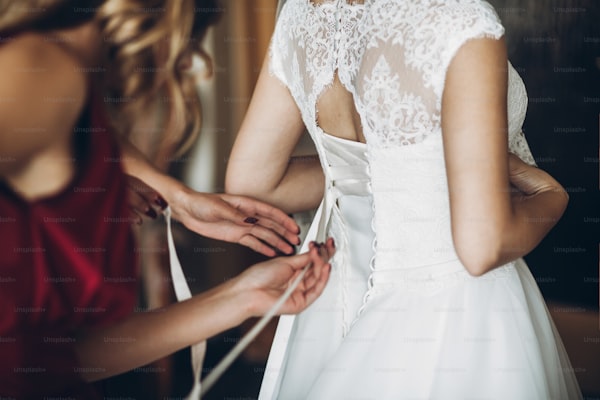Mastering Wedding Dress Alterations: Managing a Fitted Bodice and Full Skirt
How Do You Handle Alterations for a Wedding Dress with a Fitted Bodice and Full Skirt?
Choosing the perfect wedding dress is one of the most memorable moments for any bride. However, when it comes to alterations, especially for a dress with a fitted bodice and full skirt, many brides feel overwhelmed. This article will walk you through the essential steps on how to handle these alterations effectively, ensuring that your dress fits like a glove on your special day.
Understanding the Dress Structure
Before delving into the alterations process, it is essential to understand the general structure of a wedding dress, particularly those with a fitted bodice and a full skirt. The fitted bodice is designed to hug the body and often features various types of structure, such as boning and underlining. The full skirt provides volume and can be made from a variety of materials, adding to its shape.
Step 1: Assessing the Fit
The first step in handling alterations for your wedding dress is assessing the fit. Here are some things to consider:
- Measure Your Size: Take accurate measurements of your bust, waist, and hips. Keep in mind that sizes can vary significantly between designers.
- Consider the Style: A fitted bodice often needs to accommodate your bust size, while the full skirt should allow for movement and flair.
- Check the Length: Make sure the dress is the right length, especially if you are wearing heels on your wedding day.
Common Alterations for Fitted Bodices
When working with a fitted bodice, several common alterations can be made:
- Taking In or Letting Out: Depending on your measurements, a seamstress can take in or let out the bodice to achieve a perfect fit. This is particularly important for brides who may lose or gain weight leading up to their wedding.
- Adjusting the Straps: For dresses with straps, adjustments may be required to ensure they align comfortably on your shoulders.
- Enhancing Support: If the bodice lacks support, consider adding boning or a built-in bra to provide structure and ease of movement.
Common Alterations for Full Skirts
For the full skirt portion of the dress, alterations may include:
- Hem Length: The hem may need to be adjusted to ensure it is the correct length for walking comfortably.
- Adding a Petticoat: Depending on the volume you desire, a petticoat can add extra fullness to the skirt.
- Adjusting the Waistline: It may be necessary to adjust the waistline to complement the fitted bodice and enhance your silhouette.
| Common Alterations | Description |
| Taking In/Letting Out | Adjust the bodice to fit the bust, waist, and hips. |
| Strap Adjustments | Align straps for comfort and support. |
| Hem Length | Cut or extend the length of the skirt. |
| Add a Petticoat | Increase volume for a fuller look. |
| Waistline Adjustments | Align waistline to fit the bodice. |
Finding a Professional Seamstress
Finding the right seamstress is crucial in achieving the perfect fit for your wedding dress. Here are some tips:
- Research Recommendations: Ask friends or browse online forums for local seamstresses specializing in wedding dress alterations.
- Check Online Reviews: Platforms like Yelp or Google Reviews can provide valuable insight into previous customers’ experiences.
- Schedule Consultations: Meet with potential seamstresses to discuss your needs and assess their ability to make recommendations.
Budgeting for Alterations
Budgeting for alterations is an important step in the wedding preparation process. Here’s a breakdown of common costs:
- Fitted Bodice Alterations: Typically range from $100 to $300, depending on the extent of the work required.
- Full Skirt Alterations: Hemming and adjusting skirts can range from $50 to $150.
- Additional Charges: Be aware of potential extra charges for rush jobs or complex adjustments.
Timing the Alterations
Timing is crucial when it comes to alterations. Here are some pointers:
- Start Early: Begin alterations at least 8-12 weeks before the wedding to have ample time for fittings and adjustments.
- Plan for Multiple Fittings: Typically, two to three fittings are necessary for the best results.
- Keep Final Measurements in Mind: It’s essential to settle on your final size a few weeks before the wedding to avoid last-minute changes.
Maintaining Your Wedding Dress Post-Alterations
Once your alterations are complete, it’s essential to maintain your dress until the big day. Consider the following:
- Storage: Store your dress in a breathable garment bag to protect it from dust and damage.
- Avoid Moisture: Keep the dress in a cool, dry place to avoid any mold or mildew.
- Final Check: Before the wedding day, do a final inspection to ensure everything fits as expected.
Conclusion: Achieving Your Dream Bridal Look
Handling alterations for a wedding dress with a fitted bodice and full skirt can be daunting, but with the right approach, you can achieve your dream bridal look. From understanding the structure and seeking professional help to budget management and timing, these steps will ensure your gown fits perfectly.
As you embark on this journey, remember to keep an open line of communication with your seamstress, avoid last-minute decisions, and enjoy the process. Proper planning and consideration will ultimately lead to a flawless fit that makes you feel exceptional on your special day.
